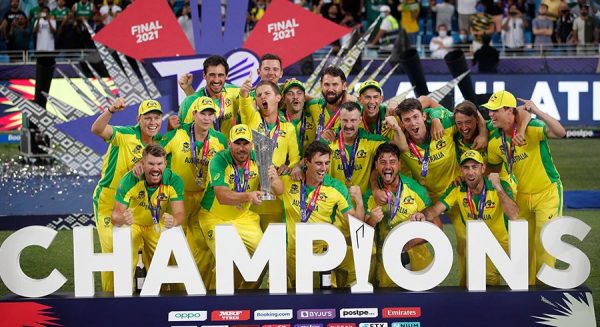Kane Williamson’s innings deserved the Cup. But a Mitchell Marsh-led Australian assault ensured that the New Zealand bowlers blew it up. Imperiously, the men in Green and Gold chased down the victory target of 173 at the cost of just two wickets with seven balls to spare. The Blackcaps suffered another final heartbreak, this time to a better team.
New Zealand actually lost the T20 World Cup final in the first 10 overs, when they scored 57/1, batting first. A fifth-gear switch in the next 10 overs made their total very challenging. But on a beauty of a surface, befitting a T20 final, they were still about 20 runs below par. Aaron Finch’s customary toss win meant that Australia were batting second, when the ball was coming even more nicely on to the bat. And although a couple of deliveries from Mitchell Santner turned, David Warner and Marsh were unperturbed in pursuit of Australia’s first T20 world title which adds to their trophy cabinet containing five 50-over World Cup trophies.
Finally, more than a decade after Dean Jones had made the prediction, Marsh chose the world stage to rise to stardom. Until this game, the 30-year-old has been a fine allrounder, a utility man, with ups and downs in his career. Belatedly, he became a match-winner to anchor Australia to the title. His 50-ball 77 not out was worthy of the Player of the Match accolade. It rattled the Kiwis for its audacity. A six followed by back-to-back fours off Adam Milne gave Australia the psychological upper hand over their trans-Tasman rivals early into their chase apart from triggering a Powerplay run-rate upsurge. Australia carried that advantage until the last ball of the game, when Glenn Maxwell reverse-lapped Tim Southee to break into a war dance, Marsh in tow.
“This kid is the next superstar of Australian cricket, no doubt,” the late Jones had said in 2010. But an injury-prone career, the latest setback being an ankle injury during the Indian Premier League last year, took time to fulfil its potential. Jones didn’t live to see Marsh’s finest hour. Far afield in Perth, his father Geoff must be a proud man.
“I don’t really have words, what an amazing six weeks with this group. Love them to death,” Marsh said at the post-match presentation.
For Warner, it was atonement. For Marsh, it was carrying forward a great family legacy that boasts three Baggy Green holders. A 92-run second wicket partnership between the two that slammed the door shut on the Kiwis, revelled in its power-punch as also tactical brilliance. Marsh attacked Santner, while Warner took on Ish Sodhi, who bowled some ordinary deliveries under pressure. Once the spin-choke was cancelled out, Jimmy Neesham was the last man standing for New Zealand, bowling-wise. Marsh sent him a few rows back over the deep fine leg boundary and Warner joined the fun with another maximum. New Zealand ran out of options.
Working in sync
For Marsh, it was about facing the New Zealand bowling. Warner had the added challenge to silence the naysayers. Only about a month ago, the sun seemingly was setting on his T20 career. On Sunday, he made hay while the moon shone in the Dubai sky.
Marsh allowed Warner to grow into the game and it was important. For the 35-year-old left-hander, this tournament was a lot more than just turning up for Australia and scoring runs. This was about returning to global prominence yet again from the desolation row of the IPL. A flat-bat six off Neesham to bring up a 34-ball half-century had a bout of anger, attested by the bat-speed and the ferocity of the shot. An aggregate of 289 runs from seven matches earned Warner the Player of the Tournament award.
New Zealand bowled some loose stuff and Sodhi wasn’t the only offender. Bereft of swing, Southee chose back-of-length, becoming ineffective in the process. Trent Boult was the only saving grace in New Zealand bowling, but his 2/18 from four overs wasn’t enough. Dropped catches of Marsh made matters worse.
Australia bossed the game from start to finish, save the 10 overs during New Zealand’s innings, when Williamson painted a picture. From 21 off as many balls at one stage, the New Zealand captain exploded, capturing the attention of a sparse turnout that sort of reluctantly walked through the turnstiles. Some fans had India face paints, a few shouted for Pakistan. Williamson made them watch cricket.
A Mitchell Starc over triggered the acceleration. A dropped catch by Josh Hazlewood contributed to the first boundary. A couple of fours followed, including one off a no-ball. Maxwell came, and Williamson went one-handed for a six. Another six next ball took him to a 32-ball half-century. Williamson upped the ante, taking Starc to the cleaners in his next over. It was cultured aggression, utterly bewitching. A century beckoned, but a leg-cutter from Hazlewood ended Williamson’s innings on 85 (48 balls), as he departed to a standing ovation. Finch ran across from backward point to give a pat on the back. Hazlewood, meanwhile, made up for his dropped catch with figures of 3/16 from four overs; an outstanding performance on a featherbed.
Looking back though, Williamson and Martin Guptill would probably rue their slow burn, when they crawled at less than six runs per over. Leaving the attack for a little too late didn’t augur well for the Kiwis. Yes, the Australian bowlers were excellent to start with, cutting down the angles and bowling to the field. But in Williamson and Guptill, New Zealand had enough quality to counter that by embracing adventurism, especially on a good pitch.




